If I had a nickel for every time I’ve reviewed a D&D 5th Edition Starter Set, I’d have four nickels. Which isn’t a lot, but it’s a weird that it’s happened four times.
This particular starter set is Heroes of the Borderlands, and it’s designed to introduce new players to the D&D 2024 version of the game. I’ve previously reviewed:
- D&D Starter Set (2014, featuring The Lost Mine of Phandelver)
- D&D Essentials Kit (2019, featuring Dragon of Icespire Peak)
- D&D Starter Set: Dragons of Stormwreck Isle (2022)
If you’ve read those reviews, then you know that what I’m looking for in a starter set is a complete game. I feel strongly that no one should buy a game, take it home, and then discover that it’s just a disposable advertisement for the game they should have bought in the first place.
I also feel strongly that an effective starter set desperately needs to do a superb job of introducing new Dungeon Masters to the game. When new players buy a D&D starter set, they’re expecting it to show them how to play their first roleplaying game, and the entire experience is lynchpinned on the DM. You can’t just cross your fingers and hope they’ll figure it out on their own.
Last, but not least, the introductory adventure should (a) ideally be multiple adventures and (b) show off the unique strengths of tabletop roleplaying games. If your premiere gateway product is a railroaded nightmare or makes D&D look indistinguishable from Gloomhaven, then something has gone wrong.
(You also get bonus points if you include some sort of solo play option, so that someone opening the box on Christmas morning can immediately dive in, get a little taste of what RPGs can be like, and get excited enough to gather their friends ASAP for a proper session.)
With these principles as our guiding light, I concluded that Lost Mine of Phandelver, in the 2014 Starter Set, was quite possibly the best introductory adventure ever published for D&D (in no small part because it was actually a full-blown campaign). The rulebook in that set was also notable because it included enough source material (monsters, magic items, and so forth) that it felt like a DM could continue designing and running their own adventures even after completing the included adventure. It was hampered only by the lack of character creation rules.
The Essentials Kit, in 2019, significantly improved the rulebook by including character creation, but lacked the same robust selection of monsters and magic items. The Dragon of Icespire Peak adventure was a solid entry, but also a bit of a downgrade from Lost Mine of Phandelver. Combining the Starter Set and the Essentials Kit, on the other hand, would give you a near perfect introductory set.
In 2022, Dragons of Stormwreck Isle tried to supplant both its predecessors… and failed. Character creation was gone, the rulebook was gutted, and the adventure was mediocre at best. This was a disposable and disappointing set.
In the end, Frank Menzter’s 1983 D&D Basic Set remained the reigning champion of D&D introductory sets.
Can Heroes of the Borderlands dethrone it?
OPENING THE BOX
The core content of Heroes of the Borderlands is contained in the Play Guide, which serves as the rulebook, and three adventure booklets: Keep on the Borderlands, Wilderness, and Caves of Chaos.
Then you’ve got the bling:
- 9 double-sided poster maps
- 5 glossy handouts
- Pregen character boards for a Cleric, Fighter, Rogue, and Wizard (1st, 2nd, and 3rd level for each)
- Gobs and gobs of tokens (monster tokens, player tokens, terrain tokens, power tokens, hit point tokens, gem tokens, gold piece tokens)
- Background cards
- Species cards
- Magic item cards
- Spell cards
- Equipment cards
- NPC cards
- Monster cards
- A pad of Combat Tracker sheets
- A full set of dice (include 4d6 and 2d20)
It’s a lot of bling! And most of it is fully illustrated. You can definitely see where the $50 MSRP went.
RULEBOOK
In looking at the Play Guide, I think there are two key questions:
- How well does this function as an actual D&D rulebook?
- Would I want to learn D&D by reading this book?
And, obviously, these questions are pretty intertwined with each other.
Well, let’s start at the beginning: The sequencing of the Play Guide is quite poor. For example, they try to describe all the Actions in the game before they explain how Turns work, which is hopelessly confusing. And they mention D20 Tests like a dozen times before telling the reader what they are. Simple procedures are needlessly cluttered up with exceptions, and the exceptions being based on rules that don’t appear until later doesn’t help.
At a more fundamental level, the Play Guide, following the lead of the 2024 Player’s Handbook, is a glossary-based rulebook. Glossary-based rulebooks kinda suck for a multitude of reasons, but they’re particularly disastrous at teaching new players how to play a game: Instead of presenting the rules as a series of instructions, they instead decouple the mechanics and expect the reader to reassemble the procedures of play. In addition to being inherently confusing, they’re also prone to making glaring mistakes, and the Play Guide inherits a bunch of mistakes from the core rulebooks without blinking an eye.
For example, in the main text the Influence action is defined as making a Charisma check to alter a creature’s attitude. In the glossary, however, the Influence action is defined as making a monster do something you want and the monster’s attitude is now a modifier on the check. If you’re an experienced DM, this is the kind of thing that just makes you sigh and shake your head. But it’s a needless booby trap for a brand new player just trying to figure out the game.
(The rules that directly contradict each other probably also distracted you from the Influence action only being usable on monsters, not NPCs. Which is just a straight-up mistake.)
You’ll also discover that core game concepts are missing from this rulebook. Proficiency bonuses, for example, have been baked into the pregen character sheets without any explanation of what they are or where they come from.
So, would I want to learn D&D from this book?
No. It’s sloppy, poorly organized (particularly for a first-time player), and incomplete.
And how well does this function as an actual D&D rulebook? Or is this just disposable trash designed to be thrown away after playing it once?
The answer here is a bit more nuanced, because the box does, for example, include a pretty diverse array of monsters, while the adventures books, as we’ll talk about in a moment, make a couple of half-hearted attempts to encourage the would-be DM to create their own adventure content. The limited character creation rules, on the other hand, have to be a pretty large ding, and the overall vibe is definitely disposable.
Most damning for me, personally, is that if you learned the game from this rulebook and then joined a group playing with the Player’s Handbook, you’d immediately be blindsided by the missing core concepts. So it’s very limited as a stand-alone experience, but also inadequate as a pathway to learning and playing the full game. It’s just a subpar manual across the board.
THE ADVENTURES
The three adventure booklets are a lot more exciting.
A single DM can take the three adventure booklets — Wilderness, Keep on the Borderlands, and Caves of Chaos — and use them as a traditional adventure or mini-campaign. But Heroes of the Borderlands also offers a more radical proposal: You can give each adventure booklet to a different player, with each one serving as the DM whenever the PCs go to the region covered by their booklet.
This is insanely cool!
First, it’s incredible to see such a big, daring concept in a product aimed at new gamers. It really challenges the engrained expectations of the RPG hobby, and even if only one table in a hundred takes the bait and begins experimenting with shared campaign worlds and other alternative structures for organizing their campaigns, that’s still a triumph.
Second, it’s such a great way to encourage more new players to try out the role of the Dungeon Master.
I’m assuming Justice Ramin Arman, the lead designer on Heroes of the Borderlands, was the one to come up with this concept and he deserves all the kudos in the world for it. This kind of thinking — and a willingness to experiment — is vital if you’re serious about growing the hobby.
As far as the adventures themselves go, there’s a goodly amount of adventure material in each one (you can expect to run this boxed set for several sessions) and, in terms of quality, it’s solid stuff.
For each adventure booklet, you start by pulling out the poster map for the region and laying it on the table:
Then you simply ask the players, “Where do you want to go?”
In the case of the Wilderness, as seen above, the choices are:
- Trail
- Woods
- Tamarack Stand
- Fens
- Keep on the Borderlands
- Caves of Chaos
In this case, if the players choose to go to the Keep or the Caves of Chaos, you would swap to those adventure booklets (although possibly only after triggering one or more Trail encounters on the way there). Otherwise, you simply flip to the matching sub-region in the adventure booklet and run the encounters and/or locations detailed there.
Everything about this great. It’s a simple structure for a novice DM to grok and use. It empowers the players without overwhelming them. And the adventure material is lightly spiced with just enough clues, job offers, and the like to link the various regions together and give the players the opportunity to start pursuing specific goals.
(Although if they just keep pointing at stuff and saying, “Let’s go there now!”, that works, too.)
QUIBBLES
I do have a few quibbles with the adventures, though.
For starters, if you’re going to suggest that separate DMs could each take a separate adventure booklet and swap their PCs in and out, then you need to make sure that none of the booklets have spoilers for the other booklets. There aren’t too many of these, but they do crop up. Notably, several of these are actually phrased as tips or reminders: “Hey! Don’t forget the huge spoilers over in the Caves of Chaos!” Normally that would actually be good praxis, but here it’s fighting one intended use of the booklets.
The biggest misfires of Heroes of the Borderlands, in fact, are often places where it seems to be fighting with itself.
 For example, the original Keep on the Borderlands adventure by Gary Gygax on which Heroes of the Borderlands is based, is, in my opinion, a brilliant introductory adventure in large part because of the moment when the PCs step into a gorge and behold the Caves of Chaos for the first time: A dozen different cave entrances line the gorge’s walls! Which one do you want to enter?
For example, the original Keep on the Borderlands adventure by Gary Gygax on which Heroes of the Borderlands is based, is, in my opinion, a brilliant introductory adventure in large part because of the moment when the PCs step into a gorge and behold the Caves of Chaos for the first time: A dozen different cave entrances line the gorge’s walls! Which one do you want to enter?
The very first action that the PCs take in the adventure is a choice. And that choice will completely reshape how the adventure plays out. It’s a moment that immediately tells a new player everything they need to know about how an RPG is supposed to work.
Initially, it seems like Heroes of the Borderlands is going to capture that same magic! “Look at this map! Just point at where you want to go!” it says. In fact, it does it three times over! Once for the Caves, again for the Wilderness, and again for the Keep!
… but then the authors immediately tell the first-time DM to take the choice away and tell the players where to go. For example, from the Caves of Chaos booklet:
Cave A functions as a tutorial with helpful sidebars. If this is your first time as the DM, encourage the players to start there.
And you can see that the intention is good: We prepped a tutorial for you!
But look at the effect it has! Instead of teaching the DM to give the players free choice, you tell them to take it away. Instead of new players having that defining moment of realizing THE CHOICE IS YOURS, their first moment in the game is instead the DM telling them what their choice will be.
First impressions matter. Wizards of the Coast has this immense privilege of being the gateway to the RPG hobby. It’s a shame that they so often prove utterly incompetent at introducing new players to the game: Not just failing to help them, but actively going out of their way to teach them the wrong things to do.
In any case, as I mentioned before, the wealth of adventure material is generally well done and supported with a plethora of poster battlemaps.
There are a few encounters that are conceptually weird: A huge forest fire that’s also surprisingly short-lived. An NPC hireling that follows video game logic (just standing around until the players click him and tell him to fight, then returning to his spawn point where the players can fetch him again). A bank that charges 10% interest per DAY. An unintentionally hilarious bit where three hobgoblins and their four goblin followers are planning to besiege a castle that has dozens of armored knights defending it.
I think my favorite along these line is: “We’ve set up a town where you can’t buy rations because we didn’t want to include rules for that, but we’re going to frame up a ‘your hungry RIGHT NOW’ encounter where you have to immediately choose which color of pine nuts you’re going to eat, and if you choose wrong you’re going to be POISONED!”
Beyond these oddities, the material in general does suffer a bit from a lack of depth. I think the intention was to make it easier for 8-year-olds to run the game (even though the box says 12+), but I’m not sure it was the right approach. In my opinion, it’s easier to run a scenario when you understand WHY stuff is happening in the scenario. So shallow material occasionally plagued by illogical nonsense tends to leave a lot of booby traps
There are other booby traps, too, like a quest to make a map with more details than the maps given to the DM (which puts the new DM in a tough spot to start improvising the necessary details) and milestone leveling guidelines in each of the adventure booklets that, as far as I can tell, are simply incompatible with each other. (Not inconsistent. Incompatible.)
But these are, as noted, quibbles and isolated incidents. Everything here is serviceable enough. It’s mostly frustrating because it’s so close to being a lot better than the “this is OK” that it ends up being.
MISSED OPPORTUNITIES
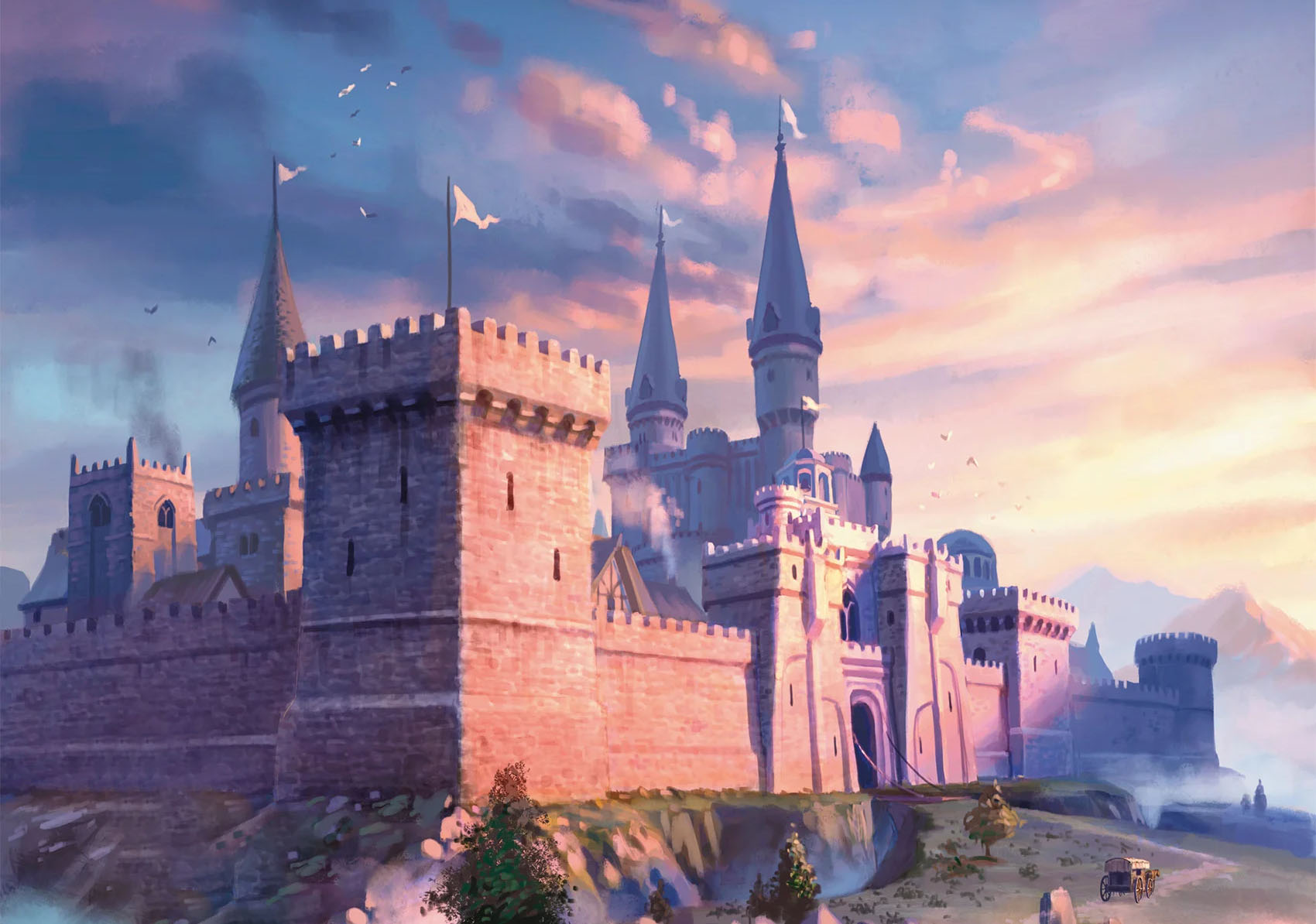
Along those same lines, there are some pretty big missed opportunities in Heroes of the Borderlands.
For example, at the end of the Wilderness book, there are eight random encounters given for each of the four sub-regions, for a total of thirty-two encounters. With just a little bit of cooking and a few hundred words, this material could have been coherently presented as an example of how to restock and expand the scenario.
Instead, it’s presented without any structure at all, and just kind of assumes that the new DM will magically know how to use random encounters.
Similarly, every cave in the Caves of Chaos book includes utterly inadequate “guidelines” for adjusting encounter difficulty. For example:
You can add monsters, such as allied Goblin Warriors, to the cave to make this scenario longer and more difficult, or you can remove some monsters to make it easier and shorter. One or two Hobgoblin Warriors might be out on a patrol elsewhere.
The new DM is given no indication of how or when or why they would want to adjust the difficulty. And if they do, for example, decide to make this lair more difficult… well, how many Goblin Warriors should they add, exactly? Two? Four? Eight? There are no encounter guidelines in this boxed set, so they’re shooting in the dark. Hope you don’t screw up and kill everybody!
Here’s another unforced error:
The characters can leave the Caves of Chaos any time they choose, provided they aren’t inside a cave or engaged in combat. If they return to a cave later, it is as they left it.
Now, I wouldn’t necessarily advise brand new DMs to run fully dynamic dungeons with enemies building fortifications, adversary rosters, restocking events between visits, and so forth. But I also wouldn’t go out of my way to tell them NOT to do that. Just because they’re not ready to take the next step, it doesn’t mean you should steer them onto the wrong path!
And if you’re going to include woefully under-documented suggestions for monsters DMs can add to the caves, why not include the idea of using those same monsters as a way of restocking the caves for future visits or brand new adventures?
BLING!
I’ve already listed all the additional bling in the Heroes of the Borderlands. The production values on this stuff is top-notch. It’s very attractive.
But I have to admit I have a bias against unnecessary knick-knacks. I understand the desire to add a lot of stuff to make the cover price seem “worth it,” but I just think it’s a bad idea in an introductory product to create the perception that, for example, you “need” an equipment card for every piece of equipment the PCs are carrying.
This is particularly true when the desire to have some physical component actually gets in the way of teaching new players how to actually play D&D.
But if you like bling, it’s very nice bling.
THE VERDICT
Spreading Heroes of the Borderlands out on the table in front of me, what’s the final verdict here?
Well, I can’t recommend the rulebook to anyone. Its primary job is to teach new players and DMs how to play the game, and it’s really bad at doing that.
I’m going to give the adventures a C+. It’s solid material and lots of it, and I have to give credit for the bits where the booklets dare to dream big. (Even when they’re simultaneously cutting the legs out from under a lot of those dreams.)
Combining these things together, I’m going to give the total package a C-. (I’d probably give it a D+, but I’m going to bump it up a notch because all the bling does add tangible value.) As a Starter Set for D&D, this mostly gets the job done, and there are places where true genius shines through, like the shared DMing duties and point-at-the-map introduction to exploration and adventure. I wish they’d fully committed to some of those ideas, spent more time teaching new DMs essential skills, and spent less time sabotaging both themselves and the new players trying to learn the game.
GRADE: C-
Lead Designer: Justice Ramin Arman
Designers: Jeremy Crawford, Ron Lundeen, Christopher Perkins, Patrick Renie
Publisher: Wizards of the Coast
Cost: $49.95
Page Count: 96
ADDITIONAL READING
Keep on the Borderlands: Factions in the Dungeon

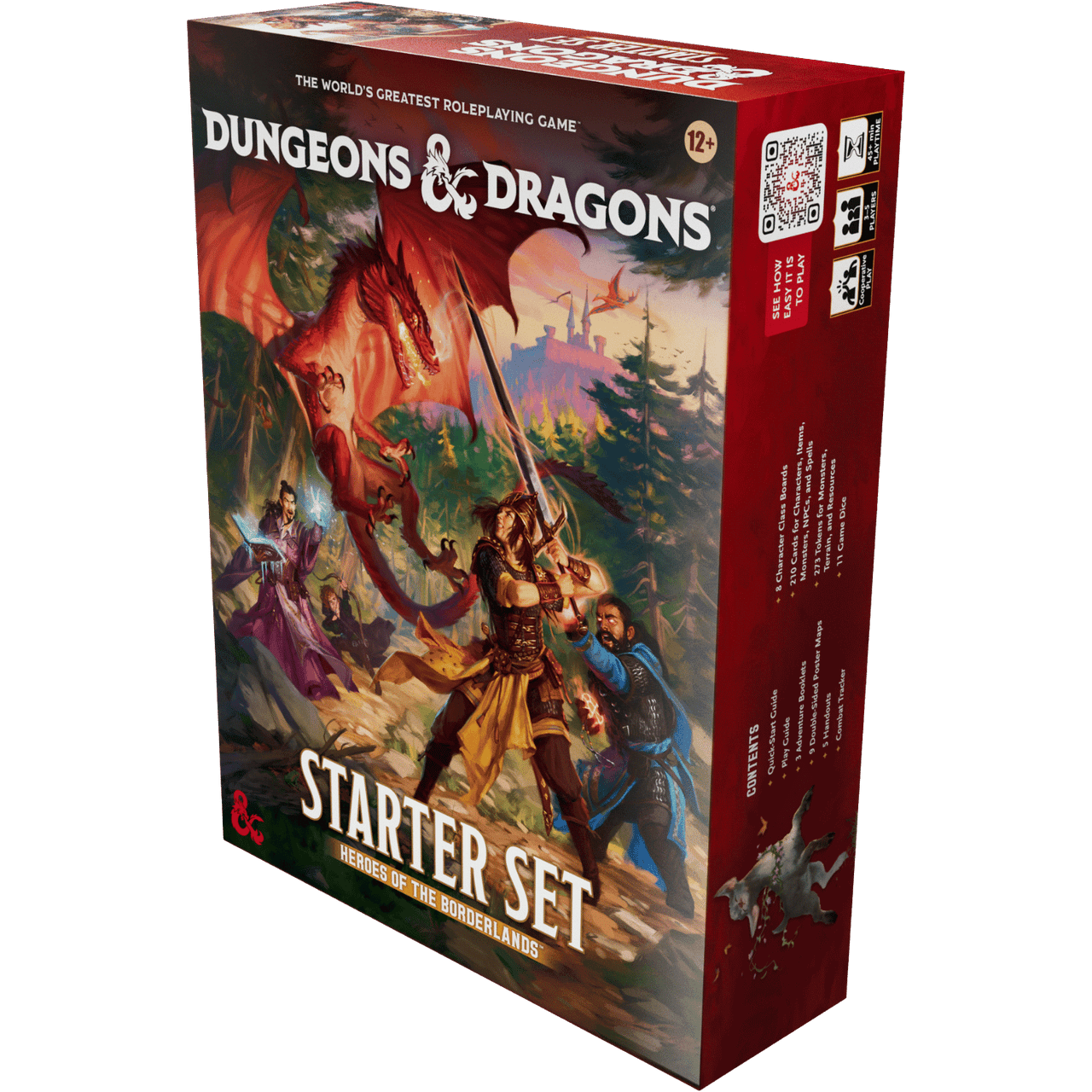
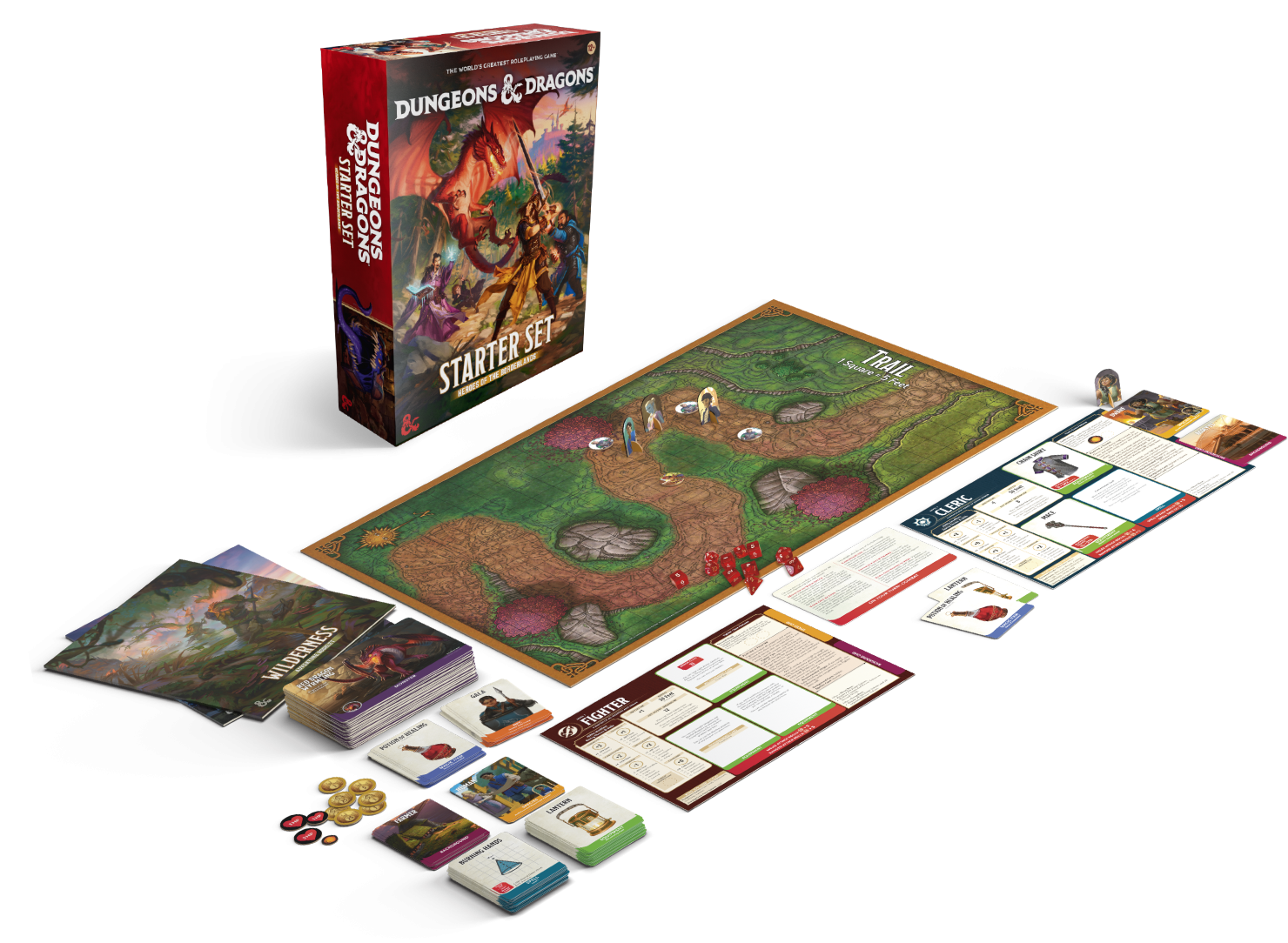
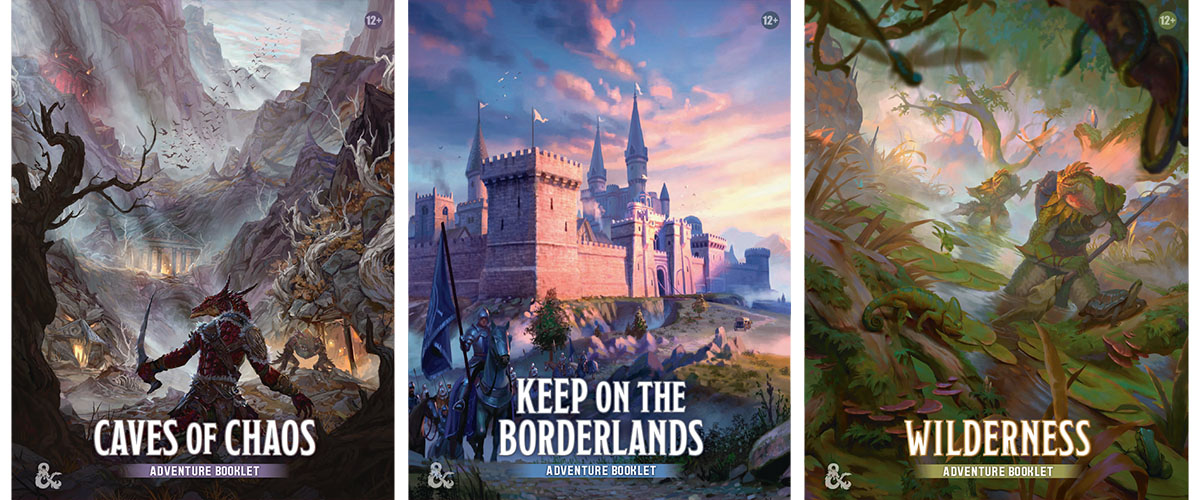
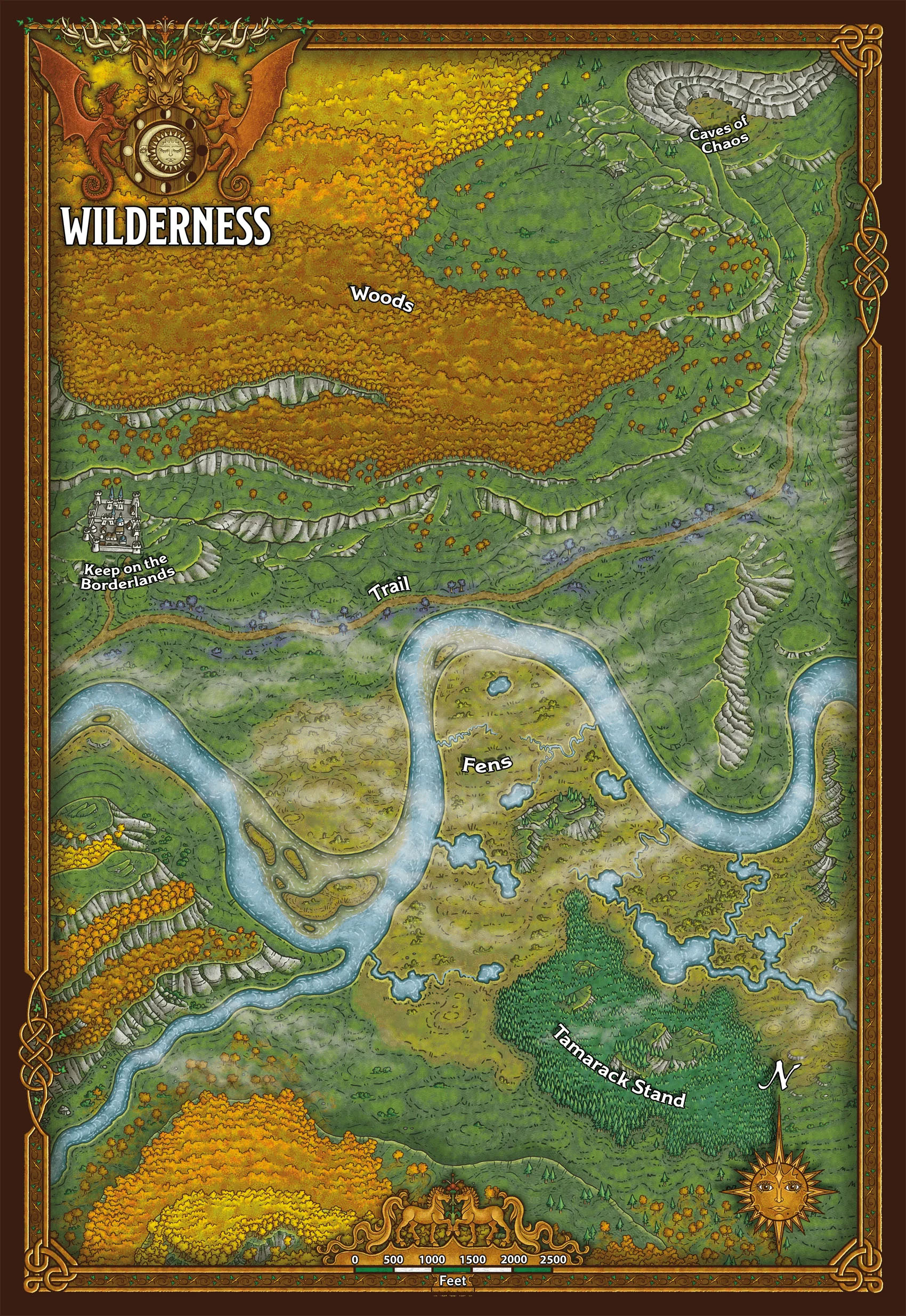











That’s pretty much what I thought it was going to be, which is why I didn’t preorder or rush out to get it. Quality on these has been pretty hit or miss with a batting average that mirrors most MLB players. Thank you for an honest review. I will seriously consider getting a reprint of Keep on the Borderlands, though, since I’ve never played or DM’d it.
You know, reading a review such as this one, I keep wondering: if you had the opportunity to review the set in advance at WotC, at a step of production where it would still be possible to implement smallish feedback, at the cost of not being allowed to publish your thoughts on the game afterward, would you take it? Let’s assume that no money is on the table, the goal isn’t to turn that into a consultancy fees discussion. Knowing the impact such a starter set can have on a new generation of gamers, would you rather get a shot at improving things with no guarantee that your feedback would find its way into the final product or would you rather keep your ability to comment publicly and freely on the product at the cost of possibly doing the autopsy of a failure rather than a life-saving operation ?
I’d understand both sides, but I’m rather curious to know where you see yourself.
If I had some sort of guarantee that my vision actually made it to print, that’s a gig I’d definitely be interested in.
But I’ve been burned a few too many times in this industry to assume that would actually happen.
A great review, and I concur with much of what you’ve shared.
I did purchase this with the express idea of teaching my grandkids how to play, and the “bling” helps in the excitement factor. They’ve loved playing the set so far.
That said, when they “graduate” from this starter set, I know that I’ll need to teach them about the power of “choice” at every level of the game, from character creation with the character sheet instead of a default character card (they kind of have a choice at Level 3 with subclass selection, but that’s really “choose which side of the character card.”) And the use of which spells/weapons/etc. really is baked into the character card. It’s interesting that in the digital version of this game, you have to use character sheets, because they don’t have an analog for the use of character cards.
I agree with the weakness of presentation of rule mechanics. It looks like they just ported portions of the 2024 PHB, and made edits to refer to cards and other bling, without any special training for prospective DMs. It’s ok for those of us who have been playing who might be trying to DM for the first time (like me) who has prior familiarity with the 2024 rules, but definitely not for those who are new to RPGs.
On a plus side, those equipment, spell, monster, etc. cards – they could prove handy tools in regular DnD play beyond the starter set. The other tokens, not so much.
Just a few thoughts. Thank you again for this review!
I think you missed the point. This is merely an introduction to the concept of DND, not a first “real” adventure (though the adventure content could certainly be used for that). From the PoV of a player, it’s a lot closer to a board game than a true TTRPG, and I think it does an amazing job doing that. I wish I had thought of it. As far as a DM running this without any experience, well that’s a pipe dream. I started with OE, and we all basically taught each other, but several of us had played war games, so we had a head start.
It’s an amazing product for its intended use.
Great review, Justin, and I think I agree with all of it. The coolest element is definitely the ‘let’s switch Dungeon Masters’ idea! Although it does feel like a bit of a sticking plaster for the root problem—the ‘DM crisis’—that DMing is just too intimidating and time-consuming for so many players. And the rules booklet doesn’t exactly help with that.
I’m also pretty sceptical of the ‘bling.’ There’s a fine line between bling and tat… I thought the 2019 box had some lovely stuff like a DM screen and sidekick cards—stuff you will actually use—but some of these cards just seem like bloat.
If you haven’t seen it, please check out the Dragonbane boxed set! It’s magnificent!
You gave this set the same grade as the 2022 one. That can’t be right.
I can kind of see the point of spell cards and magic item cards — you have to have the rules for that stuff somewhere, and on a card right in front of you is convenient — but who even has the patience for that many kinds of tokens?
I have a negative reaction to the pressure to turn D&D into a video game, which is what I see going on with that. (It’s at least board-game-ifying it, but video games are at the end of that line, pretty sure.) Sure, it can look pretty, but the more you pin things down with the idea that you have to have cards and tokens and pretty graphics for everything, the less freedom you have to go gonzo, and that’s been part of the appeal of D&D since Blackmoor. If you need tokens and cards and graphics, then there’s a place for a corporation that wants to sell them to you.
But I know I’m probably being a grouch. Lots of people like having lots of tactile stuff in their games, from fancy dice and character minis to full-on dungeon scenery. I’m a probably a bit of a weirdo way out on the other end of the spectrum of “four scribbled lines is a map” and using random beads and tchotchkes for monsters. Kids are going to get introduced to roleplaying via video games these days, that’s just how it is, and maybe providing video-game trappings like lots of tokens and markers is the right way to lure them to the tabletop? I dunno.
[…] The Alexandrian reviews Heroes of the Borderlands. […]
[…] em 2025, projetada para receber novos jogadores no mundo do RPG de mesa mais famoso do mundo [thealexandrian.net]. Com regras atualizadas da versão 2024 de D&D, este Starter Set combina a narrativa rica do […]
I think calling the Mentzer boxed set I learned the game with the gold standard of starter sets really makes me question this entire review. It presents a game far simpler than 5th edition if you are referring to BECMI, or it does a terrible job of presenting AD&D 1e because the rules of AD&D are far different than BECMI. Ability score modifiers don’t even match. It also doesn’t really have a full adventure, just a choose your path module in the PHB. If that’s what this author thinks a starter set should be then I think he is missing the point. The only thing that set taught me is how to make cookie-cutter dungeons.
D&D and Advanced D&D were not the same game in the 1980’s.
The Moldvay set is better than Mentzer
I have to wonder if the planning of this product has anything to do with their previous intention to go nearly all digital. As if this was their plan for the table-top they left behind, an RPG/board game hybrid. A super-simplified board game where they could have expansion packs every so often.
Thanks for this, Justin. I have read through more than a dozen reviews for the new starter set and yours is one of very few (it might be the only one!) that doesn’t just reword the WotC promotional information the set was released with, or just parrot the AI answers (which in any case seem to be based on the promotional material).
I have been running kids D&D games for a while now at a local store and the things which draw them in are always character creation – we sometimes spend half the session just doing that – and going off-script in the game itself. They are so inventive! They would be really confused by a D&D game that did not have either of these. Many of them have not bought any of the books yet, so it is good to know this is probably not the answer for them. The ones who have bought them lapped up the actual rules of the Player’s Handbook, again it was the depth of information and the heady levels of choice which kept them glued to the pages, not a load of bits of cardboard.
Great review – keep it up!